It:Caffeine
Introduction
Caffeine is one of the most widely used central nervous system stimulant. Caffeine is present in coffee, tea, chocolate, soft drinks (eg. red bull, coca-cola). Its effects (vary from person to person and are affected by the body size, and tolerance) include: reduced drowsiness, improved attention span, and faster blood circulation. When used in large doses and over a long period of time a 'dependancy' may arise, a person may even suffer from withdrawal symptoms if they stop taking it.
Spectra
Below are the 13C NMR and the IR spectra of caffeine
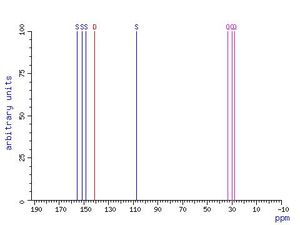
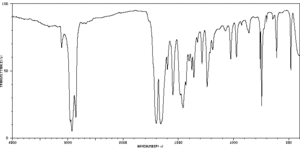
| Caffeine | |
|---|---|
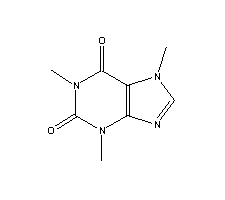
| |
| Chemical name | 1,3,7-trimethyl-2,6-dioxopurine |
| CAS nummber | 58-08-2 |
| Chemical formula | C8H10N4O2 |
| Molecular mass | 194.1926 g/mol |
| Melting point | 238 °C |
| Boiling point | 178 °C |
| Water Solubility | 1-5g/100 ml at 23 C
1g/5.5 ml at 88 C |
| Density | 1.23 |
| Comments | White solid, usually powder or needle-like
Light sensitive |
Synthesis
Emil Fischer was the first person to synthesise caffeine, in 1895 however his real objective was to study purines in general. The synthesis of caffeine is not an industrially used process as its extraction from coffee beans or even tea leaves is a much more cost effective process and yields 99.5% pure caffeine. A possible way to synthesis caffeine artificially, from Uracil is shown below. The first step is to methylate the uracil, there are 3 alternate ways in which this can be done the yield however is fairly poor with 10% for method 1, 20% for method 2 and 60% for method 3, the subsequent steps involve nitration, reduction (of the nitro- group), and a ring forming reaction, to form theophylline, and an another methylation to for caffeine.
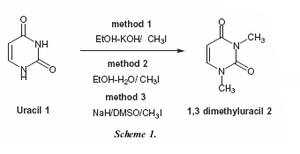
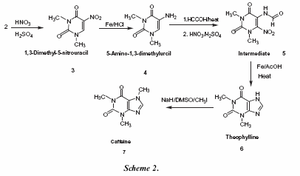
Metabolism
Caffeine is completely absorbed by the stomach and small intestine within 45 minutes of ingestion. After ingestion it is taken to all the tissues in the body and is eliminated by first oreder kinetics. The half-life of caffeine: the time required for the body to eliminate one-half of the total amount of caffeine consumed at a given time. It varies widely among individuals according to such factors such as age, liver function, pregnancy and the level of enzymes present in the liver needed for caffeine breakdown. In healthy adults, caffeine's half-life is approximately 3-4 hours. In women taking oral contraceptives this is increased to 5-10 hours, and in pregnant women the half-life is approximately 9-11 hours.
Caffeine is matabolised in the liver by the cytochrome P450 oxidase enzyme system, into three metabolic dimethylxanthines.
- Paraxanthine (84%) – Has the effect of increasing lipolysis, leading to elevated glycerol and free fatty acid levels in the blood plasma.
- Theobromine (12%) – Dilates blood vessels and increases urine volume. Theobromine is also the principal alkaloid in cocoa, and therefore chocolate.
- Theophylline (4%) – Relaxes smooth muscles of the bronchi, and is used to treat asthma. The therapeutic dose of theophylline, however, is many times greater than the levels attained from caffeine metabolism.
paraxanthine
Theorombine
Theophylline
Extraction
The main methods to extract caffeine are:
1. Methylene Chloride/Ethyl Acetate Processing
The raw materials (eg. coffee beans) are softened by steam or hot water, and then methylene chloride or ethyl acetate is added which bonds with the caffeine molecules.
2. CO2 processing
This method involves 'pressure cooking' the raw ingredients with supercritical carbon dioxide, at a high temperature and pressure, the small CO2 molecules extract the relatively small caffeine molecules, whilst the larger oils and flavouring compounds remain untouched. This makes this method popular for decaffeination of coffee.
3. Water extraction
Water extraction is similar to the methylene chloride/ ethyl acetate process, however instead of adding chemicals the raw materials are left to soak in hot water for longer, to allow the caffeine to diffuse into the water. The water is then passed through a carbon filter which removes the caffeine in the water, but as with the previous method does not affect the flavourings. The water is then passed back to the raw ingredients to allow reabsorption of these flavours.
Effects
Caffeine is used recreationally to help stay awake, while in medicine it is used to reduce headaches, as a cardiac stimulant, and also to increase urine production. The reason that caffeine reduces drownsiness is because it binds to the adenosine receptors of the nervous system (adenosine causes drowsiness), and therefore prevents adenosine from doing so. Caffeine also constricts the vessels for blood flow to the brain, and therefore increases its activity. This increased activity is percieved by the pituitary gland as a sign of danger or emergency, and it releases adrenaline, which makes the heart beat faster, pupils to dilate, and the liver to release sugars (and therefore energy). Caffeine has also got an effect on dopamine release in the brain, which 'activates the pleasure center' of the brain.
Overdosing on caffeine is possible; a small overdose (in excess of 250 milligrams) can result in overstimulisation of the nervous system (sometimes called caffeine intoxication). This causes restlessness, insomnia, muscle twitching, nervousness and a rapid heart beat. Extreme doses are also possible and can even lead to death, the lethal dose is estimated to be 150-200mg per kilo of body mass, although this is difficult to reach with coffee or tea, deaths have been reported from overdosing on caffeine pills.Long-term overuse of caffeine can also result in sleeping disorders and even psychiatric disturbances (such as anxiety , panic attacks etc).
References
1. Synthetic communications [0039-7911] Zajac yr:2003 vol:33 iss:19 pg:3291
2. [1]
